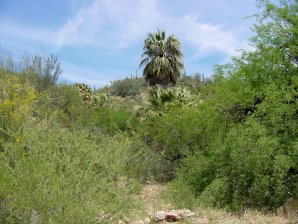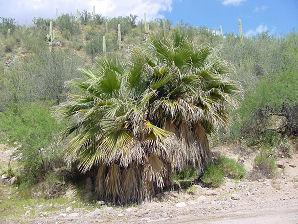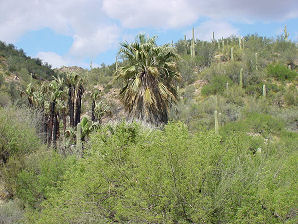Arizona Wild Flowers
Pictures, Photos, Images
Descriptions, Information, Reviews.
Washington Palm, or Mexican Fan Palm,
Washingtonia robusta.
We Are Proud Of Our SafeSurf Rating!
Click On Any Of The Following Links By Amazon.Com
For Books, & Videos About Wildflowers Of Arizona & The Southwest USA. No Obligation!
 |
| Washington Palm, or Mexican Fan Palm, Washingtonia robusta. Growing In The Desert. (Distant Center). Photo Taken May 1, 2003. Castle Hot Springs. |
|---|
 /
/

 |  |
| There Is Only One Native Species Of Palm Tree In Arizona. | These Were Found Growing At Castle Hot Springs In Hieroglyphic Mountains. |
|---|---|
 |  |
| There Is Only One Native Species Of Palm Tree In Arizona. | These Were Found Growing At Castle Hot Springs In Hieroglyphic Mountains. |
 |  |
| There Is Only One Native Species Of Palm Tree In Arizona. | These Were Found Growing At Castle Hot Springs In Hieroglyphic Mountains. |
 | |
| Mexican Fan Palm. Flowers. | Mexican Fan Palm. Flowers. |
 /
/

Washington Palm, or Mexican Fan Palm We wish to thank Wikipedia, the free encyclopedia for some information used on this page. We share images and information with Wikipedia. The Washington Palm, or Mexican Fan Palm ( Washingtonia robusta ) is native to the oases and canyons of Arizona and California. It is an evergreen. It is a popular landscape plant in Arizona, California, and Florida as well as in other areas where it is hardy, throughout the world. Its leaf fronds are up to 6 feet long, made up of a petiole up to about 6 1/2 feet long, bearing a fan of leaflets about 4.9 � 6.6 feet long. They have long thread-like white fibers, called filifera-filaments, between the segments. When the fronds die they remain attached and drop down to cloak the trunk in a wide skirt. Sometimes these skirts are called; "Hula Skirts."These skirts can be the home to unwanted insects and animals. They are known to contain wasps, bees, rats, & even rattlesnakes! They also are fire hazards. The trunk is smooth but usually hidden by these retained old leaves that "skirt" the trunk unless removed. This palm is inexpensive, easy to transplant and easy to find. It is available from nurseries, home centers and discount garden stores. It is becoming one of the commercial landscaper's favorite palms - appearing in startling numbers along Arizona's urban freeways, and in commercial and industrial developments. Another similar palm species, California Fan Palm, or Washington Palm ( Washingtonia filifera ), An evergreen, is often grown in Arizona's populated areas. Some people say that other places in Arizona are the original sites where the Washingtonia robusta was discovered, and then transplanted by the early settlers of Arizona, but there is no real evidence to support that theory. We suspect that there were several small groves of these trees in Arizona when it was first settled. We would guess that these small groves were probably spread throughout Arizona by natural influences, such as, wild birds. Or, perhaps by the Native Americans.
Here is a link to our web page about California Fan Palm, or Washington Palm ( Washingtonia filifera ). Many of the Washingtonia Palm's we see all over the cities of Arizona are non-native. They are the Washingtonia filifera palms.
Quick Notes:
Height: Generally speaking up To 45 foot or more, frond spread to 15 feet. In cultivation, they can grow up to about 100 feet tall.
Trunk: Up To About 3 Foot Thick. Thinner trunk than W. filifera.
Bark: The Bark is dark brown, and the bark texture is furrowed.
Twig: Slender, reddish-brown some thorns, later developing an exfoliating gray film; buds reddish to gray and sharp pointed; leaf scars raised.
Flowers: On stalks extending beyond foliage, small, creamy, off-white flowers. Male and female flowers on the same Inflorescence.
Blooming Time: Mid March - June.
Fruit: Pea-sized black berries. Enjoyed by birds.
Leaves: Fan-shaped fronds, 3 - 6 feet across, gray-green; margins more wider than W. filifera; tips of fronds arch down; most attractive when old yellowed fronds are allowed to accumulate against trunk. The leaves are grey-green, with cotton like threads on the leaves, and dark drown, heavily armed, shiny leaf bases.
Light: Full sun but can also grow in partial shade.
Water Requirements: It can also tolerate drought but does best in moist well drained soil. It can tolerate alkaline soil.
Fertilizer: Apply good quality palm fertilizer that has a continues release formula, twice a year during growing season.
Found: Isolated areas in the desert near water.
Elevation: 0 - 3,900 Feet.
Habitat: Southeastern California, western Arizona (USA), Baja California (Mexico), at seeps, desert bajadas, and springs.
Pests: Very Few. The fungal disease caused by Sphaerodothis neowashingtoniae, called diamond scale, can infect Washingtonia filifera and its hybrids, leading to loss of leaves and an even sparser crown.
Hardiness:
Soil pH requirements:
Miscellaneous: It is cold hardy to about 20 F and can tolerate frost. Propagated by seed. Photos Taken May 1, 2003. Castle Hot Springs. Plant has spines or sharp edges; use extreme caution when handling.
Mexican Fan Palms or Washington palms in Arizona can get their crowns blasted off by lightning since the trees often tower over neighboring trees. And Arizona has Monsoon storms. We have seen it happen!
|
We Are Proud Of Our SafeSurf Rating!



We Are Proud Of Our SafeSurf Rating!
Click On Any Of The Following Links By Amazon.Com
For Books, & Videos About Xerioscape Plants Of Arizona & The Southwest USA. No Obligation!
| © 1966 - Present, Audrey, Eve, & George DeLange |


